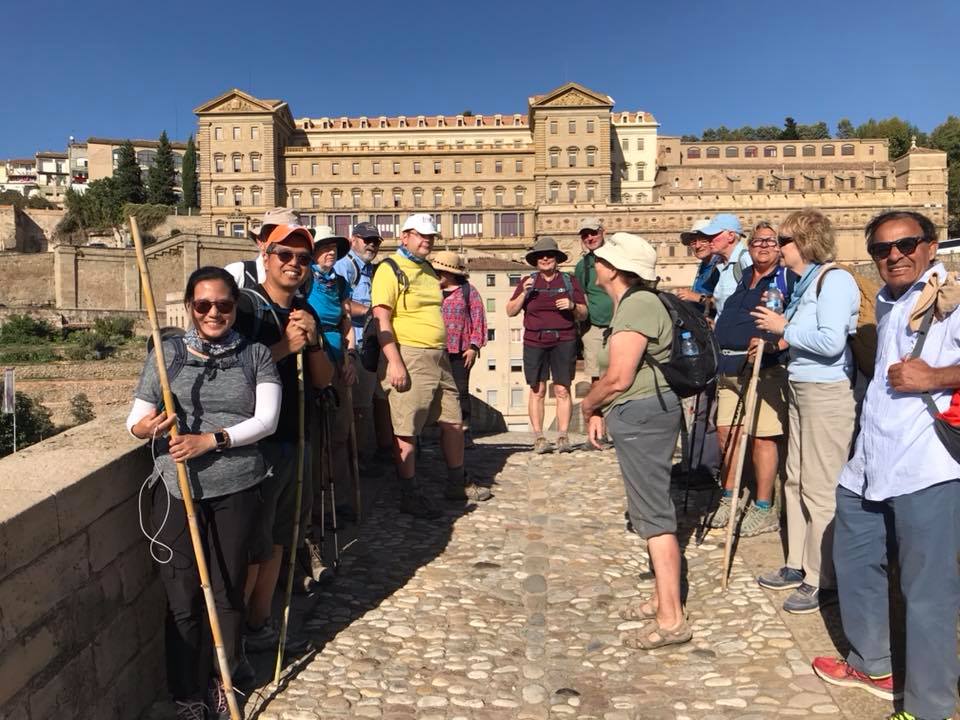by Jo Siedlecka
Eighteen pilgrims took part in this year’s Farm Street Camino, walking the route St Ignatius Loyola took in 1522 from his home town of Loyola in the Basque Country across northern Spain to Montserrat and Manresa in the east. Our own 200km Camino followed the final part of this ancient trail, through Catalunya. Led by Fr Dominic Robinson SJ, our group included two Episcopalian couples from Oklahoma, an Anglican priest, three Filipino-Canadians, as well as Australian, Scottish, Irish and English parishioners, reflecting the international outreach of Farm Street.
Fr Dominic Robinson told us: ‘It is a different way of making a retreat. Some find it easier to come closer to God in silence and with an individual prayer guide. Others prefer to do something physical and in companionship. Walking in the steps of St Ignatius is a very special way of connecting with the Spiritual Exercises. As a group we will reflect on St Ignatius’ teachings. It’s a bit like the Canterbury Tales: as we journey, we talk, we sing, we pray, we eat and drink together and we share where we are on our faith journey.’
We began our trek in the ancient town of Verdu, staying in a pilgrim hostel at the birthplace and shrine of St Peter Claver, the 17th century Jesuit priest who ministered to slaves in what is modern-day Colombia. The opening Mass and morning prayer were dedicated to victims of human trafficking.
From here we set off on our 16km walk to Cervera, on the Cami Ral, the route St Ignatius travelled on a donkey. On this beautiful, rugged trail through farmland and ancient villages, accompanied by the sound of crickets, we passed a ruined church, a hermitage and an old castle.
On that first day it was pretty hot. Fr Dominic led the way and I stayed at the back making sure we kept together. By late afternoon as we walked along a steep hillside, three of us at the end realised we had run out of water and were really starting to feel thirsty. Suddenly, three leather-clad motorcyclists roared up beside us. It turned out they were from Toulouse. They asked how we were and gave us some water. The kindness of strangers was something we were to experience many times more on our Camino.
Our next stop was Igualada, where St Ignatius bought his pilgrim robe and staff. Once a busy textile town, there is some unusual old industrial architecture: chimneys that resemble lookout towers from a Tolkien story, combined with modern sculptures and outside escalators.
We stayed in the Moly Blanc hotel, a beautiful converted mill, and attended Mass in Catalan at the modern Church of the Holy Family. The next leg of the journey was exciting, as the steep path took us along hairpin bends and curves up and up the mountain to the Benedictine monastery of Santa Maria de Montserrat tucked underneath huge outcrops of rock that looked like lumbering giants. From the top there were magnificent views of Catalan landscape. It was here that St Ignatius came and prayed for three days and nights before the Black Madonna of Montserrat, patron saint of Catalonia. One morning we took a cable car up the mountain and walked to the hermitage of St Jerona. It was quite a stiff climb on the designated footpath, but we saw several young people equipped with rock-climbing ropes and tackle taking more adventurous routes, abseiling up the sheer rock faces.
The path out of Montserrat next day was very steep, but eventually it levelled out and took us through woods at the bottom of a long valley.
At a place called Castellgali we came across a sad monument to two nuns, Sr Regina and Sr Rosa, who were shot here, in July 1936, during the Spanish Civil War. We continued along through fields and vineyards, until we reached an ancient winery where we stopped to eat our sandwiches. Nearby there was a Roman road marker pointing towards Manresa, which Ignatius would have seen on his journey.
He would probably have recognised Manresa today too. The tall gothic church on a hill and the ancient bridge over the River Cardoner were already old in his time. We stayed at the Jesuit centre here, built over the small cave where Ignatius lived for eleven months and wrote his Spiritual Exercises. It’s now a chapel with a beautiful baroque altar. Engraved in the stone wall are two small crosses said to have been carved by the saint. During our stay we visited several of the places where St Ignatius worked and prayed.
With our Camino ended, we took a coach to the beautiful city of Barcelona, home to St Ignatius for several years. We stayed in the Spiritual Exercises Centre for a time of prayer and relaxation, visited some of the sites associated with St Ignatius and went sightseeing around the city: to Gaudi’s Sagrada Familia and up to Tibidabo, a small mountain overlooking the city with a Salesian church that was visited by St John Bosco.
The hardest part was saying goodbye on our last day. In two weeks we had become good friends. We will be keeping in touch, and many of us will be back on the Ignatian Camino again next year.
Photo: Wilbur Maxino




